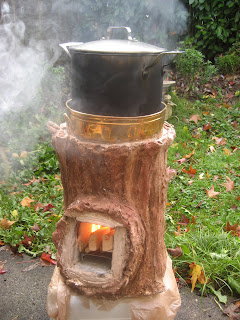I guess I'm really in the heating world, not the cookstove world, because the first thing that came to mind was this:
from
templefire.net
I think it might be the same one being built here:
http://www.mha-net.org/single-skin-heater-workshop-alex-chernov/
But that's not a ton of cooktop space. (Is that what you meant by "hop" space?)
English stone cottage makes me think Aga, or one of the lovely big iron ranges. I don't know about their efficiency.
I suspect that, as with bake ovens, the biggest efficiency is still up to the cook. Care in laying and tending the fire; paying attention to wood used and very dry storage for that wood.
Cooking for more people at once, and reducing the time spent cooling and re-heating the equipment.
I don't see a lot of cooking ranges with much insulation around the firebox.
I think that's a key element if you want to get more heat at the stove, less elsewhere for summer cooking: is the firebox insulated?
and ideally, are the baffles that you'd use to shut off the oven or divert heat between different burners also insulated?
Even if you don't want to cut into the frame and relocate the door to make a rocket cooker like in Max's example, you might be able to line an older firebox with slices of insulating kiln brick. This would reduce the firebox size slightly but ensuring that the fire gets hotter, and more of that heat from the smaller fire reaches the burners.
With both, you'd want to make sure that wherever this intense heat hits first, temperatures are still within the design parameters of that part.
Anyone cooking on a wood stove that they are very happy with? Care to speak to the efficiency options?
At the DIY level, there's also this Australian, Grant Steven, improvising variations on rocket cooktops and ovens ... here's a hot plate he was working on a while back:
https://www.youtube.com/watch?v=8w6O4VAaz-U
I don't know that his stuff would be more efficient in terms of wood consumption, unless you used it as intended - for very large groups. Cooking in big batches reduces the heat wasted in warm-up and cool-down of individual household systems if they're being fired up for brief periods.
For those brief tasks like boiling water for tea, or reheating something on a bain-Marie, it might pay to have a very small, efficient, super-insulated rocket tea stove. With a skirt that fits around one or two of the pots you use most often. I boil a tea kettle a lot more often than I do anything else with the stove, and I have a kettle and a pressure cooker about the same size that could fit in the same pot skirt. That's a lot of daily cooking tasks that could be done without firing up the big range.
www.rocketstove.org has some examples of solar and rocket cookstoves that you can make yourself.
One that we did from high-end refractory stuff for an outdoor preschool came out like this:
(Note it's for outdoor use, the smoke comes up around the pot inside the brass pot-skirt.)

Here's the innards before we decorated it:

Due to constraints of space, it does not have as tall a chimney as it might, and it still emits some smoke.
(It had to fit on top of a picnic table, and be carried back into storage after; and the teacher had to be able to cook on it standing at the picnic table, and we did not want the kids knocking it over with a heavy pot on top).
There's a bigger one in Paul Wheaton's Hot Rockets DVD, but that too emits more smoke than we'd like.
I have finally gotten my fox stove dimensions down to where last year's model was completely smokeless, but I don't have rocket cookstoves dialed in to completely smokeless yet.
It's just hard to get the flames a consistent-enough height that the pot can sit just above them, but not in them. Pot in flame = flames cooled down before burning the soot = black smoke and soot up the sides of the pot.
Anyone building rocket cookstoves they are very proud of, with super-minimal wood use and no smoke?
-Erica

